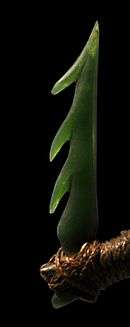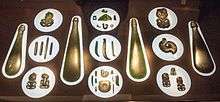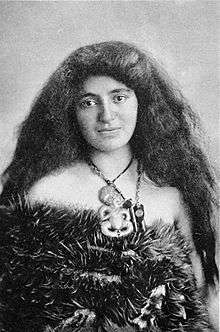Pounamu



Pounamu refers to several types of hard, durable and highly valued nephrite jade, bowenite, or serpentinite stone found in southern New Zealand. Pounamu is the Māori name. These rocks are also generically known as "greenstone" in New Zealand English.
There are two systems for classifying pounamu. Geologically, the rock falls into the three categories named above, but Māori classify pounamu by appearance.[1] The main classifications are kawakawa, kahurangi, īnanga, and tangiwai. The first three are nephrite jade, while tangiwai is a form of bowenite.[2]
- Īnanga pounamu takes its name from a native freshwater fish (Galaxias maculatus) and is pearly-white or grey-green in colour and varies from translucent to opaque.[3]
- Kahurangi pounamu is highly translucent and has a vivid shade of green. It is named after the clearness of the sky and is the rarest variety of pounamu.[4]
- Kawakawa pounamu comes in many shades, often with flecks or inclusions, and is named after the leaves of the native kawakawa tree (Macropiper excelsum). It is the most common variety of pounamu.[5]
- Tangiwai pounamu is clear like glass but in a wide range of shades. The name comes from the word for the tears that come from great sorrow.[6]
In modern usage pounamu almost always refers to nephrite jade. Pounamu is generally found in rivers in specific parts of the South Island as nondescript boulders and stones. These are difficult to identify as pounamu without cutting them open.
Significance to Māori

Pounamu plays a very important role in Māori culture. It is considered a taonga (treasure) and therefore protected under the Treaty of Waitangi. Pounamu taonga increase in mana (prestige) as they pass from one generation to another. The most prized taonga are those with known histories going back many generations. These are believed to have their own mana and were often given as gifts to seal important agreements.
Pounamu taonga include tools such as toki (adzes), whao (chisels), whao whakakōka (gouges), ripi pounamu (knives), scrapers, awls, hammer stones, and drill points. Hunting tools include matau (fishing hooks) and lures, spear points, and kākā poria (leg rings for fastening captive birds); weapons such as mere (short handled clubs); and ornaments such as pendants (hei-tiki, hei matau and pekapeka), ear pendants (kuru and kapeu), and cloak pins. [7][8] Functional pounamu tools were widely worn for both practical and ornamental reasons, and continued to be worn as purely ornamental pendants (hei kakï) even after they were no longer used as tools.[9]
Pounamu is found only in the South Island of New Zealand, known in Māori as Te Wai Pounamu ("The [land of] Greenstone Water") or Te Wahi Pounamu ("The Place of Greenstone"). In 1997 the Crown handed back the ownership of all naturally occurring pounamu to the South Island tribe Ngāi Tahu,[10][11] as part of the Ngai Tahu Claims Settlement.
Modern use
Jewellery and other decorative items made from gold and pounamu were particularly fashionable in New Zealand in the Victorian and Edwardian years in the late 19th and early 20th century.[12][13] It continues to be popular among New Zealanders and is often presented as gifts to visitors and to New Zealanders moving overseas. Viggo Mortensen, Aragorn in The Lord of the Rings, took to wearing a hei matau around his neck. Michael Hurst of the television programme Hercules was given a large and heavy pounamu pendant necklace which he wore on the programme. During a particularly energetic action scene the pendant bumped his teeth. The producers felt the ornament suited the nature of the programme yet considered it a safety risk, and had it replaced with a latex replica.
Gallery
 Maori woman with kiwi feather cloak and hei-tiki pendant.
Maori woman with kiwi feather cloak and hei-tiki pendant. Maori chief holding a mere.
Maori chief holding a mere. Maori woman with tattooed chin wearing a pekapeka pendant.
Maori woman with tattooed chin wearing a pekapeka pendant. Hinepare, a woman of the Ngāti Kahungunu tribe. She is wearing a pounamu hei-tiki around her neck, and one pounamu earring and one shark tooth earring
Hinepare, a woman of the Ngāti Kahungunu tribe. She is wearing a pounamu hei-tiki around her neck, and one pounamu earring and one shark tooth earring- Ear pendant (pekapeka), Maori people, pounamu and red sealing wax
.jpg) Kataore, Mere pounamu (42 cm x 12 cm) named after a Ngāi Tahu chief killed by Te Rauparaha in the 1830s. Gifted by Riwai Keioni Te Ahu, Te Ati Awa to Sir George Grey.
Kataore, Mere pounamu (42 cm x 12 cm) named after a Ngāi Tahu chief killed by Te Rauparaha in the 1830s. Gifted by Riwai Keioni Te Ahu, Te Ati Awa to Sir George Grey. A portrait of Wahanui Reihana Te Huatare, carrying a mere and wearing a heitiki made of pounamu
A portrait of Wahanui Reihana Te Huatare, carrying a mere and wearing a heitiki made of pounamu A portrait of Rangi Topeora, wearing numerous pounamu items.
A portrait of Rangi Topeora, wearing numerous pounamu items. Nephrite pounamu hei-tiki
Nephrite pounamu hei-tiki- A kuru (straight earring). Kapeu are similar, but with curved ends, and are also used as teething aids.[14]
- A kākā pōria, a bird leg ring used to fasten decoy birds used in hunting.[15]
References
- ↑ "Pounamu – An iconic stone". Kura Pounamu Treasured stone of Aotearoa New Zealand. Museum of New Zealand Te Papa Tongarewa. Retrieved 21 November 2010.
- ↑ Keane, Basil (2 March 2009). "Pounamu – jade or greenstone – Pounamu – several names". Te Ara – the Encyclopedia of New Zealand. Ministry for Culture & Heritage. Retrieved 21 November 2010.
- ↑ "Inanga pounamu". Kura Pounamu Treasured stone of Aotearoa New Zealand. Museum of New Zealand Te Papa Tongarewa. Retrieved 21 November 2010.
- ↑ "Kahurangi pounamu". Kura Pounamu Treasured stone of Aotearoa New Zealand. Museum of New Zealand Te Papa Tongarewa. Retrieved 21 November 2010.
- ↑ "Kawakawa pounamu". Kura Pounamu Treasured stone of Aotearoa New Zealand. Museum of New Zealand Te Papa Tongarewa. Retrieved 21 November 2010.
- ↑ "Tangiwai pounamu". Kura Pounamu Treasured stone of Aotearoa New Zealand. Museum of New Zealand Te Papa Tongarewa. Retrieved 21 November 2010.
- ↑ "Pounamu taonga". Collections Online. Museum of New Zealand Te Papa Tongarewa. Retrieved 25 November 2010.
- ↑ Keane, Basil (2 March 2009). "Pounamu – jade or greenstone – Implements and adornment". Te Ara – the Encyclopedia of New Zealand. Ministry for Culture & Heritage. Retrieved 21 November 2010.
- ↑ http://collections.tepapa.govt.nz/Publication/3154
- ↑ "Pounamu Management Plan", Te Rūnanga o Ngāi Tahu
- ↑ "Ngāi Tahu and pounamu", Te Ara – the Encyclopedia of New Zealand
- ↑ "Pounamu – a special gift". Kura Pounamu Treasured stone of Aotearoa New Zealand. Museum of New Zealand Te Papa Tongarewa. Retrieved 21 November 2010.
- ↑ "Pounamu items from the history collection". Collections Online. Museum of New Zealand Te Papa Tongarewa. Retrieved 21 November 2010.
- ↑ http://collections.tepapa.govt.nz/Topic/1988
- ↑ http://collections.tepapa.govt.nz/Topic/1989
External links
| Wikimedia Commons has media related to New Zealand greenstone. |
- Photos of 40 Pounamu varieties with accompanying information
- Pounamu, Te Rūnanga o Ngāi Tahu
- "Pounamu – jade or greenstone" in Te Ara – the Encyclopedia of New Zealand
- Examples of pounamu taonga (Māori treasures) from the collection of the Museum of New Zealand Te Papa Tongarewa
- First over the Alps: The epic of Raureka and the Greenstone by James Cowan (eText)
- Photo of woman wearing a greenstone neck pendant
- Photo of greenstone tiki
- Photo of greenstone mere
- H. D. Skinner, Otago University Museum (1936). "New Zealand Greenstone". Transactions and Proceedings of the Royal Society of New Zealand. 65: 211–220.
- F. J. Turner, Otago University (1936). "Geological Investigation of the Nephrites, Serpentines, and Related "Greenstones" used by the Maoris of Otago and South Canterbury". Transactions and Proceedings of the Royal Society of New Zealand. 65: 187–210.